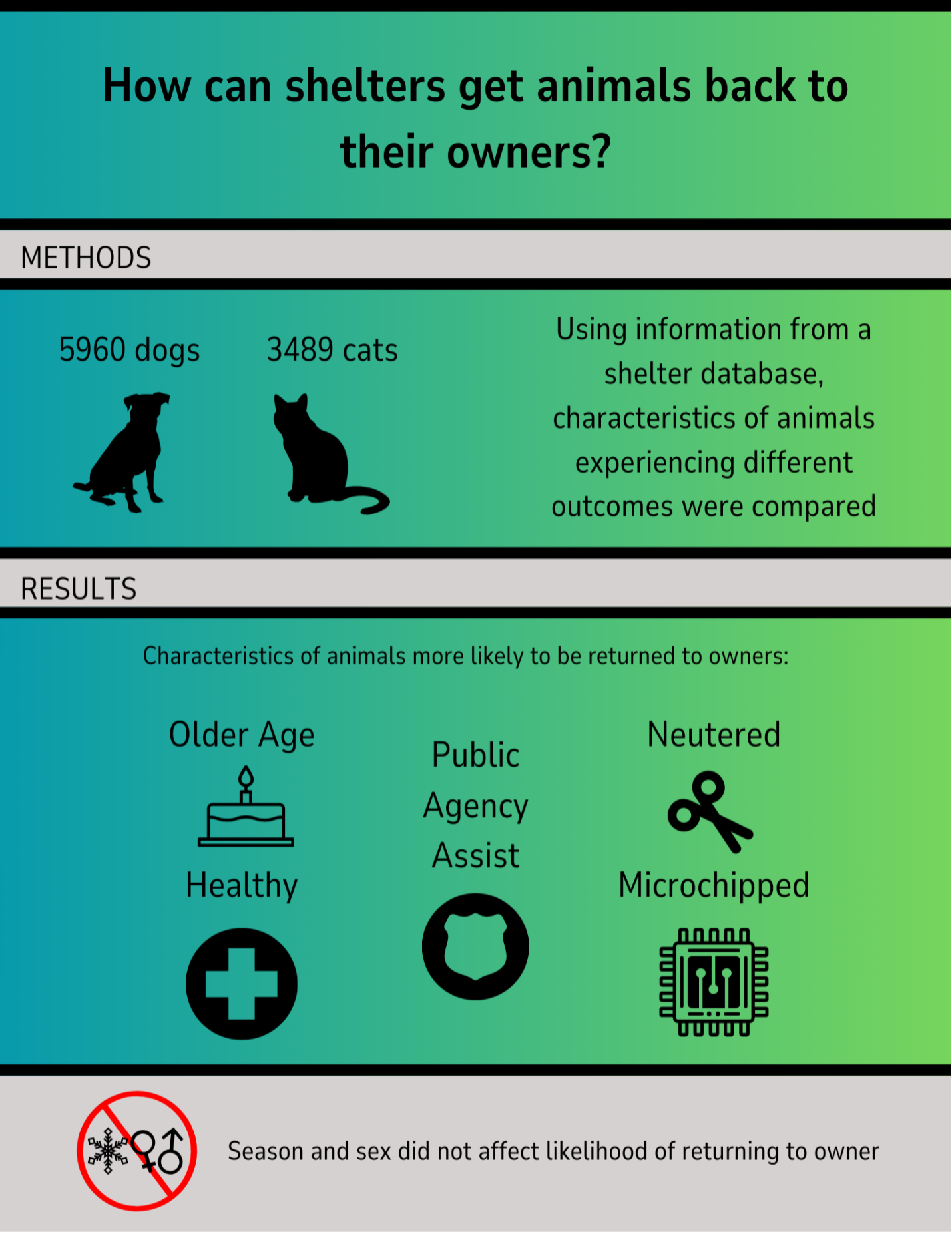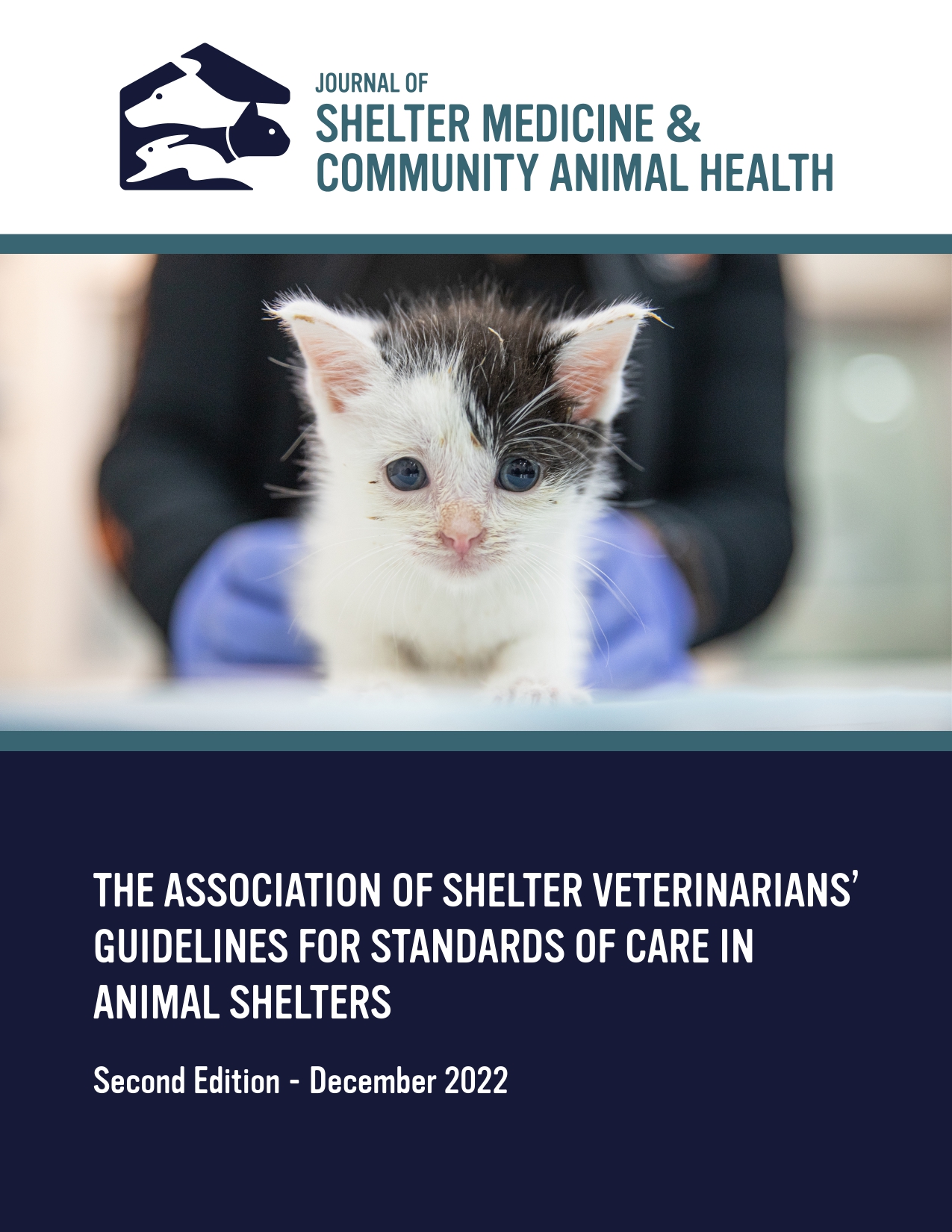Factors Affecting the Likelihood of Dogs and Cats Returning to Their Owners at a Municipal Animal Shelter in the United States
DOI:
https://doi.org/10.56771/jsmcah.v2.64Keywords:
return to owner, reclaim, RTO, directed acyclic graphs, DAGs, microchipAbstract
Introduction: Animal shelters consider return-to-owner (RTO) as an ideal outcome for animals, owners, and shelters. Methods to increase RTO likelihood are frequently discussed by shelter professionals nationwide. Some of these methods are evidence-based, while others are anecdotally successful. This retrospective study aimed to provide evidence for commonly suggested methods, as well as identify additional factors influencing RTO likelihood.
Methods: Data from 5,960 dog and 3,489 cat impounds were obtained from a large municipal animal shelter in Utah, USA. Directed acyclic graphs were developed to visualize causal assumptions, which were used to identify confounders for adjustment in the logistic regression while modeling the associations between study variables and RTO outcomes for both dogs and cats.
Results: Dogs and cats with microchips, older animals, healthy animals, neutered animals, and animals brought to the shelter via another public agency were more likely to return to their owners. Animal sex and season of impound did not affect either dogs’ or cats’ RTO likelihood.
Conclusion: The characteristics influencing RTO likelihood were similar for both dogs and cats. These influences provide support for existing shelter practices, such as facilitating widespread microchipping and waiving reclamation fees, while also encouraging implementation of new practices, such as modifying stray hold periods based on source type or health status. Limitations of the study included the presence of incomplete information in the database and concerns with the generalizability of results to other shelters.
Downloads
References
Best Friends Animal Society. The State of U.S. Animal Sheltering 2022. 2022. https://network.bestfriends.org/sites/default/files/2023-06/National%20Shelter%20Data%20Set%202023_updated_6.12.2023.pdf. Accessed August 10, 2023.
Lord LK, Wittum TE, Ferketich AK, Funk JA, Rajala-Schultz PJ. Search and Identification Methods that Owners Use to Find a Lost Dog. J Am Vet Med Assoc. 2007;230(2):211–216. doi: 10.2460/javma.230.2.211
The Association of Shelter Veterinarians. The Guidelines for Standards of Care in Animal Shelters. J Shelter Med Community Anim Health. 2022. doi: 10.56771/ASVguidelines.2022
American Society for the Prevention of Cruelty to Animals. Position Statement on Responsibilities of Animal Shelters. https://www.aspca.org/about-us/aspca-policy-and-position-statements/position-statement-responsibilities-animal-shelters. Accessed August 12, 2023.
Best Friends Animal Society. Training Playbook: Return-to-Owner. https://network.bestfriends.org/sites/default/files/inline-files/RTO_Training%20Playbook%20_PSF_8.17.2022.pdf. Accessed August 12, 2023.
Lord LK, Ingwersen W, Gray JL, Wintz David J. Characterization of Animals with Microchips Entering Animal Shelters. J Am Vet Med Assoc. 2009;235(2):160–167. doi: 10.2460/javma.235.2.160
Vučinić M, Radisavljević K, Hammond-Seaman A, Ilieski V. Visibly Marked and Microchipped Lost Dogs Have a Higher Chance to Find Their Owners in Belgrade. Maced Vet Rev. 2015;38(1):79–83. doi: 10.14432/j.macvetrev.2014.12.035
Lancaster E, Rand J, Collecott S, Paterson M. Problems Associated with the Microchip Data of Stray Dogs and Cats Entering RSPCA Queensland Shelters. Animals. 2015;5(2):332–348. doi: 10.3390/ani5020332
Fatjó J, Bowen J, García E, et al. Epidemiology of Dog and Cat Abandonment in Spain (2008–2013). Animals. 2015;5(2):426–441. doi: 10.3390/ani5020364
Zak J, Voslarova E, Vecerek V, Bedanova I. Impact of Mandatory Microchipping on Traceability of Sheltered Dogs in the Czech Republic. J Appl Anim Welf Sci. 2018;21(2):108–119. doi: 10.1080/10888705.2017.1376203
Zupcic A, Surbek M, Kabalin AE, Dragovic J, Mencik S, Ostovic M. Missing Cat Features Influencing Their Returning to Owners. Vet Medicina. 2020;65(9):394–400. doi: 10.17221/185/2019-VETMED
Kremer T. A New Web-Based Tool for RTO-Focused Animal Shelter Data Analysis. Front Vet Sci. 2021;8:452. doi: 10.3389/FVETS.2021.669428
Patronek GJ, Glickman LT, Moyer MR. Population Dynamics and the Risk of Euthanasia for Dogs in an Animal Shelter. Anthrozoos. 1995;8(1):31–43. doi: 10.2752/089279395787156455
Weiss E, Slater MR, Lord LK. Retention of Provided Identification for Dogs and Cats Seen in Veterinary Clinics and Adopted from Shelters in Oklahoma City, OK, USA. Prev Vet Med. 2011;101(3–4):265–269. doi: 10.1016/j.prevetmed.2011.05.008
Hurley K, Levy J. New Paradigms for Shelters and Community Cats. https://vetmed-maddie.sites.medinfo.ufl.edu/files/2014/07/New-Paradigms-for-Shelters-and-Community-Cats.pdf. Accessed August 18, 2023.
Meyers H. What’s the Best Age to Bring Your New Puppy Home? American Kennel Club; 2021. Updated May 31, 2023. https://www.akc.org/expert-advice/puppy-information/best-age-bring-puppy-home/. Accessed October 10, 2023.
Nagamori Y, Payton ME, Duncan-Decocq R, Johnson EM. Fecal Survey of Parasites in Free-Roaming Cats in North-Central Oklahoma, United States. Vet Parasitol. 2018;14:50–53. doi: 10.1016/j.vprsr.2018.08.008
Horecka K, Porter S, Amirian ES, Jefferson E. A Decade of Treatment of Canine Parvovirus in an Animal Shelter: A Retrospective Study. Animals. 2020;10(6):939. doi: 10.3390/ani10060939
Hall EJ, Carter AJ, Farnworth MJ. Exploring Owner Perceptions of the Impacts of Seasonal Weather Variations on Canine Activity and Potential Consequences for Human–Canine Relationships. Animals. 2021;11(11):3302. doi: 10.3390/ani11113302
Dolan ED, Doyle E, Tran HR, Slater MR. Pre-Mortem Risk Factors for Mortality in Kittens Less Than 8 Weeks Old at a Dedicated Kitten Nursery. J Feline Med Surg. 2021;23(8):730–737. doi: 10.1177/1098612x20974960
Creevy KE, Grady J, Little SE, et al. 2019 AAHA Canine Life Stage Guidelines*. J Am Anim Hosp Assoc. 2019;55(6):267–290. doi: 10.5326/JAAHA-MS-6999
Eichelberg H, Seine R. [Life expectancy and cause of death in dogs. I. The situation in mixed breeds and various dog breeds]. Berliner und Munchener Tierarztliche Wochenschrift. 1996;109(8):292–303.
Quimby J, Gowland S, Carney HC, DePorter T, Plummer P, Westropp J. 2021 AAHA/AAFP Feline Life Stage Guidelines. J Feline Med Surg. 2021;23(3):211–233. doi: 10.1177/1098612X21993657
UnitedStatesZipCodes.org. 2012. Updated June 2, 2023. https://www.unitedstateszipcodes.org/. Accessed April 13, 2023.
Lepper M, Kass PH, Hart LA. Prediction of Adoption versus Euthanasia among Dogs and Cats in a California Animal Shelter. J Appl Anim Welf Sci. 2002;5(1):29–42. doi: 10.1207/S15327604JAWS0501_3
Brown WP, Davidson JP, Zuefle ME. Effects of Phenotypic Characteristics on the Length of Stay of Dogs at Two No Kill Animal Shelters. J Appl Anim Welf Sci. 2013;16(1):2–18. doi: 10.1080/10888705.2013.740967
Stelow EA, Bain MJ, Kass PH. The Relationship between Coat Color and Aggressive Behaviors in the Domestic Cat. J Appl Anim Welf Sci. 2016;19(1):1–15. doi: 10.1080/10888705.2015.1081820
Breed Weight Chart. American Kennel Club. 2017. https://www.akc.org/expert-advice/nutrition/breed-weight-chart/. Accessed February 17, 2023.
Pearl J. Causal Diagrams for Empirical Research. Biometrika. 1995;82(4):669–688. doi: 10.1093/biomet/82.4.669
Murray JK, Roberts MA, Whitmars A, Gruffydd-Jones TJ. Survey of the Characteristics of Cats Owned by Households in the UK and Factors Affecting Their Neutered Status. Vet Rec. 2009;164(5):137–141. doi: 10.1136/vr.164.5.137
Textor J, van der Zander B, Gilthorpe MS, Liśkiewicz M, Ellison GTH. Robust Causal Inference Using Directed Acyclic Graphs: The R Package ‘Dagitty.’ Int J Epidemiol. 2016;45(6):1887–1894. doi: 10.1093/ije/dyw341
McGreevy P, Masters S, Richards L, et al. Identification of Microchip Implantation Events for Dogs and Cats in the VetCompass Australia Database. Animals. 2019;9(7):423. doi: 10.3390/ani9070423
Bannasch MJ, Foley JE. Epidemiologic Evaluation of Multiple Respiratory Pathogens in Cats in Animal Shelters. J Feline Med Surg. 2005;7(2):109–119. doi: 10.1016/j.jfms.2004.07.004
Aziz M, Janeczko S, Gupta M. Infectious Disease Prevalence and Factors Associated with Upper Respiratory Infection in Cats Following Relocation. Animals. 2018;8(6):91. doi: 10.3390/ani8060091
Pizano S. The Best Practice Playbook for Animal Shelters. Gatekeeper Press; 2021.
Crawford HM, Fontaine JB, Calver MC. Using Free Adoptions to Reduce Crowding and Euthanasia at Cat Shelters: An Australian Case Study. Animals. 2017;7(12):92. doi: 10.3390/ani7120092
Faver CA. Sterilization of Companion Animals: Exploring the Attitudes and Behaviors of Latino Students in South Texas. J Appl Anim Welf Sci. 2009;12(4):314–330. doi: 10.1080/10888700903163534
Lem M. Barriers to Accessible Veterinary Care. Can Vet J. 2019;60(8):891–893.
Spehar D, Wolf P. The Impact of an Integrated Program of Return-to-Field and Targeted Trap-Neuter-Return on Feline Intake and Euthanasia at a Municipal Animal Shelter. Animals. 2018;8(4):55. doi: 10.3390/ani8040055
Patronek GJ. Use of Geospatial Neighborhood Control Locations for Epidemiological Analysis of Community-Level Pet Adoption Patterns. Am J Vet Res. 2010;71(11):1321–1330. doi: 10.2460/ajvr.71.11.1321
Reading AS, Scarlett JM, Berliner EA. A Novel Approach to Identify and Map Kitten Clusters Using Geographic Information Systems (GIS): A Case Study from Tompkins County, NY. J Appl Anim Welf Sci. 2014;17(4):295–307. doi: 10.1080/10888705.2014.905783
Spencer T, Behar-Horenstein L, Aufmuth J, et al. Factors that Influence Intake to One Municipal Animal Control Facility in Florida: A Qualitative Study. Animals. 2017;7(12):48. doi: 10.3390/ani7070048
Dyer JL, Milot L. Social Vulnerability Assessment of Dog Intake Location Data as a Planning Tool for Community Health Program Development: A Case Study in Athens-Clarke County, GA, 2014–2016. PLoS One. 2019;14(12):e0225282. doi: 10.1371/journal.pone.0225282
Hernan MA. Causal Knowledge as a Prerequisite for Confounding Evaluation: An Application to Birth Defects Epidemiology. Am J Epidemiol. 2002;155(2):176–184. doi: 10.1093/aje/155.2.176

Additional Files
Published
Issue
Section
License
Copyright (c) 2023 C. Ryan Hill, Hsin-Yi Weng, Alexandra Protopopova, Lexis H. Ly

This work is licensed under a Creative Commons Attribution 4.0 International License.









